Welcome to Ang Aninag, the official website of the UPIS Media Center!
Don't wanna be here? Send us removal request.
Text
MALIGAYANG ARAW NG KASARINLAN, UPIS! 🇵🇭☀️
Ngayong araw, ating ginugunita ang ika-127 na taon ng pagdedeklara ng kasarinlan ng Pilipinas mula sa Imperyong Kastila—isang pinaghirapang paglaya na nagbunga mula sa kagitingan at sakripisyo ng mga Pilipinong nangarap at kumilos para sa kanilang pinanghawakang prinsipyo, soberanya, at kalayaan na hinangad nilang matamasa ng mga susunod na henerasyon matapos ang nagdaang mga siglo ng kolonyal na pananamantala at paniniil.
Subalit hindi pa nagtatapos ang pakikibaka para sa tunay na kalayaan.
Sa panahong ito na walang kasiguraduhan—kung saan laganap ang korapsyon, diskriminasyon, at nababakas ang kawalan ng pagkakaisa ng gobyerno—ang selebrasyon ng Araw ng Kasarinlan ng Pilipinas ay hindi lamang tumitigil sa pag-alala sa ating tagumpay laban sa mga mananakop. Nagsisilbi dapat itong tanda sa ating mga Pilipino sa kung ano ang bansang ating hinuhubog at itinataguyod sa kasalukuyang panahon.
Ang pagiging makabayan, sa puno’t dulo, ay hindi nasusukat sa lakas ng ating pagkanta sa Pambansang Awit o sa kung gaano kadalas nating isinusuot ang mga kulay ng ating bandila. Ito ay naninirahan sa pang-araw-araw na katapangan: ang pagtindig para sa katotohanan, pakikipaglaban para sa katarungan sa tuwing nawawala ang hustisya, at pagtatanggol sa karapatan ng mga mamamayang hanggang ngayon ay tahasang pinagkakaitan ng kalayaan.
Sa UPIS, tangan natin ang responsibilidad bilang mga mag-aaral, guro, at mga miyembro ng komunidad na ating pinanghahawakang kasabihan na: “Dangal, Husay, at Paglilingkod”. Ang pangingilatis, pagkikisangkot at pakikibaka para sa mas mabuting kinabukasan ay nagmumula sa ating tinatamasang kalayaan sa pagkilos na nararapat nating gamitin, protektahan, at ipaglaban.
Higit sa lahat, hindi natin dapat hayaang malimitahan tayo sa pagkamit ng pangarap na ito sa realidad. Tulad ng mga Pilipinong ating pinagmulan, mangahas tayong mangarap na ang mga susunod na henerasyon ay magkakamit ng dalisay at ingklusibong kalayaan.

0 notes
Text
PADAYON, BATCH 2025! 🌻♥️
Today marks the day you step out of the chapter of your lives that was UPIS. As you conclude this part with a smile and a final punctuation, wherever your next story may lead you, we wish you all the best—in flipping the pages, grabbing your pens, and continuing to write your journey from here on out.
Bright futures await you, our beloved Iskos and Iskas.

0 notes
Text
Happy Pride Month, UPIS! 🏳️🌈💗
"Taking a seat at the table is more than just an opportunity—it's a responsibility to represent and advocate for change." –M1ss Jade So
Ang bawat isa ay may karapatang makabilang sa diskurso patungkol sa kasarian at identidad. Hindi lamang ito pagkilala sa pagkakapantay-pantay ng lahat, kundi maging sa pagtanggap sa ating pagkakaiba-iba.💬
Sa pakikiisa natin sa pagdiriwang ng Pride Month ngayong buwan ng Hunyo, ipaglaban natin ang mas ligtas at inklusibong espasyo para sa lahat, upang makalinang ng isang lugar kung saan malayang nakapagpapahayag ng ating mga sarili.🫂✨
Ipagdiwang natin ang kalayaan at ang makulay na buhay ng mga Isko’t Iska.

3 notes
·
View notes
Text
From headlines to deadlines—this is MC ‘25 signing off.
Thank you so much for being part of our story! 📖
#MovingChapters
#MC2025 🔐💗
1 note
·
View note
Text
Generating Response To: The Improbable Banning of AI and What it Means for Education

Drawn by Cian Dimagiba of UPIS Media Center 2026
Artificial Intelligence, or more commonly known as AI, has caused quite a stir in the online world due to its controversial usage. Given its advanced technology, it has been both fascinating and horrifying. Its use in areas such as entertainment, cybersecurity, algorithms, and assistive technology for the disabled showcases its usefulness and practicality to help society. On the other hand, controversial issues such as fabricated videos, job displacement, privacy risks, and stolen art have caused AI to ultimately have a bad reputation across the globe.
All of these factors contribute to its bad reputation, but one stands out as the biggest reason why people dislike AI: its effects on the education of students worldwide. Specifically, there are concerns around academic dishonesty and how a specific type of AI called generative AI seems to propagate this unlawful act.
According to Tierney (2024), 70% of educators think the use of AI and plagiarism are interconnected with each other, and AI seems to worsen plagiarism. As a result, schools all over the world are debating whether to ban these instruments altogether. Should we prohibit the usage of AI or not, or is there perhaps another way to address the issues without jeopardizing our chance to use advanced technology to better our state of living?
But First, What Is AI?
Before that, we should first understand what AI is and its origins. In the year 1987, AI was said to be the result of trying to build something with intelligence, something that can think by itself. This intelligence was then split up into five more characteristics an intellectual being has.
Communication, as a component of intelligence, is usually associated with the ability to convey and understand complex ideas or topics;
Internal knowledge, which refers to the understanding of what we know, is an innate human trait, evidenced by our creation of epistemology as a study of knowledge;
World knowledge, which is knowing what is happening around you, is essentially the use of knowledge learned from the surrounding environment;
Intentionality, or knowing you want something, and then subsequently forming a plan to work towards achieving or gaining it;
Creativity, though varying in degree in intellectual beings, still possess some form of creativity;
All of these characteristics are from intellectual beings, but more importantly, they are also intrinsic features of humans. AI, in essence, is an attempt to mimic an intelligent being, or more specifically, a human.This has caused it to adapt to a self-improving type of nature wherein it makes itself better, just like how humans constantly try to improve themselves. Thus, AI is a program that is always learning and improving so that it may achieve intelligence in the future (Schank, 1987).
Consequently, a test called the Turing test is usually used to determine whether a machine can think like a human being. It is done by two human beings and a machine, wherein one of the humans acts as an interrogator. They would then ask questions to both the machine and the human being, and the interrogator would try to differentiate which response was human or machine. This test highlights the indistinctness of humans and AI, which has improved through the years. (George & Gillis, 2024).
AI in the Present
As a self-improving program, it has now improved tremendously from the first successful case of AI being used to play checkers in the year 1951 to the present day (Copeland, 2025). According to the European Parliament (2020) and Tableau.com (n.d.), some examples of how AI is used today include:
Algorithms that track the preferences of a certain individual to deliver personalized information, which are used in advertisements, web searches, digital assistants, social media, etc.;
Autocorrect which finds grammatical errors in texts and recommending ways on how to fix it;
Smart appliances such as smart houses, self-driving cars, or any automated appliances that are used for convenience;
Random generation which creates never-ending possibilities for world generation and non-player character (NPC) behavior, both of which are used in game generation such as Minecraft, The Last of Us, etc.; and
Digital security where AI can be used to deter the effects of cyber attacks, as well as fight the spread of misinformation and disinformation.
In the Philippine setting, the government has also been planning to use AI to develop the country. The Department of Trade and Industry (DTI) released the National AI Strategy Roadmap 2.0 (NAISR 2.0) and the Center for AI Research (CAIR), both of which are said to implement AI to improve the country’s economy. The NAISR 2.0 acts as a guide on how to use existing AI technology to solve the problems that is plaguing the country, while CAIR pertains to researching the technological innovations brought by AI that would help the Philippines tackle its ongoing issues (DTI, 2024).
AI is practically everywhere, from algorithms and assistants, to even autocorrect. Although, the word “AI” is essentially an umbrella term for programs imitating intelligence. Many types of AI are currently being used by people, and one of these is generative AI.
What Distinguishes Generative AI From Other Forms Of AI?
Generative AI is defined as a program that can create text, images, videos, or any other form of content. This specific type of AI is riddled with controversy surrounding its usage, mainly due to its inherent nature (Martineau, 2023).
An example is using a program such as ChatGPT to create AI images. For context, ChatGPT is one of the more popular forms of generative AI; it is a program where users would input what they would like the AI to generate, and the program would promptly deliver. This is especially problematic as AI uses the works of real people as the basis for its generated images. In other words, it is stealing these artworks that people have worked hard for, even though the artists were not aware of nor gave consent to their artworks being used in this way (Placido, 2023).
There is also the issue with the creation of harmful content for the sake of disinformation. Generative AI can be used to produce articles, pictures, and videos which have incorrect information. The generated media can be used to intentionally spread disinformation to the masses through the use of the internet. This could cause widespread ignorance within the topic affected and lead to grim aftermaths if things escalate (Endert, 2024).
Although there are a lot of problems regarding the usage of AI, there are still many ways AI can be used to improve the efficiency and the efficacy of a service.
The Positive Side Of Generative AI in Education
Due to the nature of AI, it can be used to aid the education of students. A review about the effects of AI in education from the years 2010 and 2020 listed its helpful uses.
It was stated that a key part of learning is through feedback, or in other words, the students asking questions. AI can be used as a personal assistant, answering the various inquiries students may have. In this way, they can have an easier time understanding subjects without having to wait for another person’s response, as AI is available 24/7. Another way is through the use of visualization. AI can efficiently create diagrams, tables, and other organizers to help students understand relationships between topics. An example given in the review was the usage of AI to help students visualize the premise and the conclusion of an argument. Lastly, AI can adjust to the needs of students in ways that the traditional way of learning through a classroom can not. This term was coined as adaptive learning wherein the AI can gather data from a student to personalize its teaching style (Zhai, et al., 2021).
AI could also be used to summarize difficult texts or concepts into more digestible versions. This could help a student who has a problem grasping a concept due to different factors like the length of text, language used, and more. AI would simplify these such that students would be able to easily understand and comprehend the content within them (Day & Chen, 2018).
Another article about AI and its effect on education has listed that an additional benefit of AI is allowing students to access a large amount of information with limited restrictions. This has helped students learn more as they are not as hindered by the materials they are provided with, now expanded due to the usage of AI (Basha, 2024).
Furthermore, AI is also used to help teachers and educators in their work. A study discussed two ways that AI has helped teachers: one was the rule-based expert system, and the other was the intelligent tutoring system.
Rule-based expert systems pertain to a system that thinks and makes decisions based on a set of rules, to such an extent that it can mimic a human being. This can be used in many ways, such as in creating appropriate work for the students and grading said work. The Intelligent Tutoring Systems (ITS) are described as a way to imitate the interactions of a student and their educators, where the AI acts as a teacher for a specific student. This is similar to what was discussed earlier, where AI is used to accommodate a student’s needs. This also helps teachers in managing their large classrooms filled with students who have different needs and capabilities (Murphy, 2019).
All of these things brought by AI have helped students and teachers in their work. But while that may be a good thing at first glance, there could be a problem hiding beneath these positives that we need to take a look at.
The Negative Side Of Generative AI in Education
Overall, AI has created a quick and convenient way for people to do their share of work, to the point that it is too easy. A new problem arises from the over-reliance of students on AI—it hinders their very own education (Basha, 2024).
If we recall earlier, it was discussed that AI is essentially an imitation of an intellectual mind, or in this case, a human mind. It has the capability to do what a human mind can, albeit with some mistakes. This has caused students to turn to generative AI as a way to do their work without putting in effort themselves—the AI does the thinking for them. This poses a big problem as actually doing the work is an essential part of learning, and using AI in such an unethical way will reduce a student’s critical thinking, problem-solving skills, decision-making skills, knowledge on the subject, and everything else academically related. All of these skills are needed for a student to properly learn the lessons they will need in the future.
AI could also negatively affect future workers as dependence on it reduces mental engagement, cognitive skills, memory capacity, attention, focus, and application of knowledge (Dergaa, et al., 2024). This can cause a snowball effect wherein unqualified employees would be appointed to jobs they could not do properly. In turn, this can spell disaster with certain jobs like engineering and medicine that are important to the lives of many, possibly affecting a lot of people if one case of negligence happens.
Moreover, AI is contributing to the worsening education crisis. According to Rappler, the Philippines has joined PISA, or the Programme for International Student Assessment, a total of two times—once in 2018 and once in 2022. Here, it was found that out of 79 countries Philippine students ranked last in reading and second to last in both math and science in 2018. For the second time we participated in the year 2022, we got sixth from the bottom in math, fifth from the bottom in reading, and third from the bottom in science. Although our ranking did improve, it remains concerning when compared to other countries near us, like Singapore, which placed first in all subjects.
We already have a horrible educational system in the Philippines with our scores being this low, and the unethical usage of AI shall exacerbate the issue even more. It would be detrimental for the present and future of not only students, but also the whole country (Punongbayan, 2023).
In other words, AI has made it so that the traditional way of learning, the one ordinarily used by teachers and students, is no longer used properly. As a result, students rely on AI instead of actually learning the lessons provided to them (Li, 2024).
Lastly, another concern with AI is its implications on the privacy of users and students. AI uses large amounts of data to accurately create responses to a question, the data used in this are usually sourced from individuals. The problem rises when sensitive information is possibly at risk of exposure through the AI (Baig & Malik, 2024). An example of this is a breach of private student documents which were used in an AI monitoring system for student mental health. The important information was then exposed affecting thousands of students (Sharma, 2025).
Where Does AI Currently Stand In The Philippine Education System?
It is no wonder that AI has gotten this infamous reputation, with it potentially harming the education system as a whole. Schools have now stumbled across a dilemma: should they ban, wait, or adopt AI into the education system (Regina & West, 2023)?
One way schools are trying to control the issue is by the use of AI trackers, which analyze texts based on characteristics from data on machine-generated and human works. Unfortunately, AI trackers are inaccurate, often flagging human-created works as AI-generated (Leechuy, 2024).
The other way is releasing official guidelines on the use of AI. Currently, some universities, the University of the Philippines (UP) included, have released their stance on the usage of AI in education. The guidelines state that AI should be used with consideration for people’s needs, preferences, and overall betterment. It was also said that humans should have authority over the AI; it should be transparent, fair, safe, and environmentally friendly. Lastly, AI must be used to improve the overall quality of the education, systems, and programs in UP by ensuring AI literacy for users, as well as collaborating with other universities for innovations on AI technology (University of the Philippines, 2023).
Adding to that, the University of the Philippines Open University (UPOU) has also released guidelines on the use of AI. It stated that students should: properly cite AI content, avoid plagiarism, disclose whether AI will be used for data gathering, and generally not use AI for illegal purposes (University of the Philippines Open University, 2024).
Accountability for the People and the Overlooked Issue
All of these guidelines about AI are helpful in counteracting the negative effects of AI on the education system. However, they still miss a crucial part of the puzzle: humans are accountable for the problem.
Humanity created this tool, so humanity has always been in control. We keep blaming AI for all the problems it has caused, even though we also play a part in it. Understanding that there is a problem is the first step to solving it, and knowing we are also at fault is one step closer to solving the crisis.
A Way Out
Artificial Intelligence, as it stands, is quite problematic, with it having drastic negative effects due to the way it is used. However, this does not mean that we should just give up on this piece of technology that has the capacity for advancements in the future.
One way to address the issue of AI in our education system is through government action.By improving education quality within the Philippines, studying becomes more enjoyable for the students. In this way, students would be more motivated to learn the lessons instead of using AI to cheat, thus helping with the problem.
Parents also have a responsibility in this matter. They should occasionally check up on their children’s education and ensure they are properly learning their lessons. It is also their responsibility to teach their children good ethics, such as honesty and integrity, which would greatly help in preventing the children from misusing AI.
Even with all of these precautions, there is still a possibility of misuse. In that case, why not just embrace it? Educators could teach their students ways on how to use AI effectively and ethically instead of banning it altogether. They could perhaps teach that creating visual organizers or asking personalized questions using AI may be beneficial in their education. In this way, not only would the students ethically use AI, but they would also learn how to effectively utilize AI to help in their studies.
We should also remember that AI is and has always been a tool in our hands; this means we have absolute control over it. For example, programmers should implement restrictions that would inhibit the unlawful use of AI. This can be done by detecting if users are using generative AI for academic purposes and then restricting access appropriately. This would hopefully help in managing the many cases of cheating brought by AI.
Aside from the creators, the users also have a responsibility. Just like any other tool, it is not the tool that is dangerous, but the people using said instruments irresponsibly. Considering this, a better solution to our current problem is to teach people ethics and the consequences of irresponsible utilization. As such, schools should teach and embed proper ethics to their own students to help with the underlying causes of the misuse of AI. This can be done through seminars, classes, or any other programs that can instill these values in the students.
Lastly, as people—with an innate kindness in ourselves , we should learn not to abuse the tools that are given to us; this way, we can continue using these tools for a better future. This is true for any other device that will be introduced to us, whether it be a weapon like a gun or a digital program like AI.
This especially applies to us students since we should learn not to use AI unethically in any way possible. We should use AI as per the school’s regulations, rules are rules for a reason and we should follow them. This applies to any cases of cheating and plagiarism, whether AI was used or not, as it will eventually come back to bite us in the end. We are given an opportunity to learn that not everyone gets; as such, we should not waste and jeopardize our chance by relying on AI.
To conclude, should AI be banned? Not necessarily. We may think that AI is a wild program that needs to be stopped or tamed, but this belief is inaccurate. AI has always been in our control this whole time, we only need to decide on how we want to use it. Humanity should learn how to take responsibility for its actions, as responsibility precedes taking action for the better good.
Overall, AI is in a strange position. There needs to be a lot of change, not only in the programming of AI, but also in our very own values, for us to effectively use it. A tool this advanced should not be used to negatively affect people’s lives. In the case of education, AI should be used to develop the system, and not to replace it entirely. As individuals, we must do our very best to contribute in making this a possibility, for the betterment of many.
May we find it in our hearts to do the right thing.
//by Ian Rafin
References:
Baig, A. & Malik, O. M. (2024). Navigating Generative AI Privacy | Challenges & Safeguarding tips. Securiti. https://securiti.ai/generative-ai-privacy/\
Basha, Y. J. (2024). The negative effects of AI tools on students in academic and real-life performance. International Journal of Social Sciences and Commerce [IJSSC], 1(3), 1-16. https://nsfjournals.com/article-files/pdf/WyWmemNe8hyG6vgiQoPO-1723214664.pdf
Copeland, B. J. (2025). History of artificial intelligence | Dates, Advances, Alan Turing, ELIZA, & Facts. Encyclopedia Britannica. https://www.britannica.com/science/history-of-artificial-intelligence#ref379826
Day, M., & Chen, C. (2018). Artificial intelligence for automatic text summarization. IEEE Conference Publication | IEEE Xplore. https://ieeexplore.ieee.org/abstract/document/8424747/authors#authors
Dergaa, I., Saad, H. B., Glenn, J. M., Amamou, B., Aissa, M. B., Guelmami, N., Fekih-Romdhane, F., & Chamari, K. (2024). From tools to threats: a reflection on the impact of artificial-intelligence chatbots on cognitive health. Frontiers in Psychology, 15. https://doi.org/10.3389/fpsyg.2024.1259845
DTI. (2024). DTI drives AI innovation with National Roadmap 2.0 and CAIR launch. Department of Trade and Industry. https://www.dti.gov.ph/archives/news-archives/dti-drives-ai-innovation-national-roadmap-2-0-cair-launch/
European Parliament. (2020). What is artificial intelligence and how is it used?. https://www.europarl.europa.eu/topics/en/article/20200827STO85804/what-is-artificial-intelligence-and-how-is-it-used
Everyday examples and applications of artificial intelligence (AI). (n.d.). Tableau. https://www.tableau.com/data-insights/ai/examples
Endert, J. (2024). Generative AI is the ultimate disinformation amplifier. Akademie, https://akademie.dw.com/en/generative-ai-is-the-ultimate-disinformation-amplifier/a-68593890
George, B, St., & Gillis, A. S. (2024). What is the Turing Test? Search Enterprise AI. https://www.techtarget.com/searchenterpriseai/definition/Turing-test#:~:text=The%20Turing%20Test%20is%20a,cryptanalyst%2C%20mathematician%20and%20theoretical%20biologist.
Leechuy, J. (2024). How Reliable Are AI Detectors? Claims vs. Reality. The Blogsmith. https://www.theblogsmith.com/blog/how-reliable-are-ai-detectors/
Li, J. (2024). Study on the positive and negative impacts of ChatGPT on the education system. Communications in Humanities Research, 51(1), 59-64. https://doi.org/10.54254/2753-7064/51/20242449
Martineau, K. (2023). What is generative AI? IBM Research. https://research.ibm.com/blog/what-is-generative-AI
Murphy, R. F. (2019). Artificial intelligence applications to support K-12 teachers and teaching: a review of promising applications, opportunities, and challenges. RAND Corporation. https://www.jstor.org/stable/pdf/resrep19907
Placido, D. D. (2023). The problem with AI-generated art, explained. Forbes.com. https://www.forbes.com/sites/danidiplacido/2023/12/30/ai-generated-art-was-a-mistake-and-heres-why/
Punongbayan, J. (2023). [In this economy] PISA 2022: nowhere to go but up? Rappler.com. https://www.rappler.com/voices/thought-leaders/in-this-economy-philippines-ranking-pisa-2022-nowhere-go-but-up/
Regina, T., & West, D. M. (2023). Should schools ban or integrate generative AI in the classroom? Brookings. https://www.brookings.edu/articles/should-schools-ban-or-integrate-generative-ai-in-the-classroom/
Schank, R. C. (1987). What is AI, anyway? AI Magazine, 8(4), 59-65. https://doi.org/10.1609/aimag.v8i4.623
Sharma, S. (2025). AI surveillance in US schools: Thousands of sensitive student documents exposed in surveillance breach, fueling privacy fears. The Times of India. https://timesofindia.indiatimes.com/education/news/ai-surveillance-in-us-schools-thousands-of-sensitive-student-documents-exposed-in-surveillance-breach-fueling-privacy-fears/articleshow/118936575.cms
Tierney, L. (2024). Perspective | statistics snapshot: the intersection of AI use in education and plagiarism. EdNC. https://www.ednc.org/perspective-statistics-snapshot-the-intersection-of-ai-use-in-education-and-plagiarism/
University of the Philippines. (2023). University of the Philippines principles for responsible and trustworthy artificial intelligence. University of the Philippines. https://up.edu.ph/up-principles-for-responsible-artificial-intelligence/
University of the Philippines Open University. (2024). Guidelines on the use of AI in teaching and learning. https://www.upou.edu.ph/wp-content/uploads/2024/01/Guidelines-on-Use-of-AI-in-Teaching-and-Learning.pdf
Zhai, X., Chu, X., Chai, C. S., Jong, M. S. Y., Istenic, A., Spector, M., Liu, J., Yuan, J., & Li, Y. (2021). A review of artificial intelligence (AI) in education from 2010 to 2020. https://onlinelibrary.wiley.com/doi/full/10.1155/2021/8812542
0 notes
Text
UPIS elects new officials for A.Y. 2025-2026
The UPIS Commission on Elections (COMELEC), composed of the Senior Council, held the Pamunuan ng Kamag-Aral (PKA) and Year-Level Organization (YLO) elections for the Academic Year 2025-2026 from March 18 to May 13, 2025.
Voting took place on May 5 and 6, after a series of pre-election events, including the filing of candidacy (March 26 to April 8), the campaign period (April 23 to 30), and the Miting de Avance (May 2). The results were announced on May 12 and posted on the pages of UPIS PKA and UPIS Senior Council 2027.

The table below shows the elected PKA 7-10 officers from the Sinag Party which won all seats this year:

During the Miting de Avance (MDA) held online via Zoom, the Sinag Party, which ran for PKA 7-10, centered its platform on continuing past reforms, encouraging collaborations, and uniting each individual in UPIS.
All members of the KAGITINGAN Party also won in the PKA 3-6 elections:

KAGITINGAN centered their platform on creating an environment where students feel brave, comfortable, and confident. Their projects include continuing their projects like the KA-store and Pasa-lamat, as well as starting new projects like the 3-6 newspaper and the Core Value Freedom Wall.
The following presents the official YLO officers name, along with their respective roles and parties:

Across all YLOs, party platforms shared a common goal: to promote unity, support students academically, and build a more engaged community. Many parties also proposed similar initiatives, such as the distribution of online reviewers, team-building activities, and many fundraisers. Notable projects included the Freshman Association’s locker fundraiser and compliment wall, the Sophomore Association’s art fair and merch selling, the Junior Association’s Junior-Senior Promenade, and the Senior Council’s career talks and inter-batch sports events.
To learn more about their proposed projects and platforms, visit these related posts from the UPIS Media Center.
UPIS Miting De Avance 2025 Transcript
UPIS PKA & YLO Elections 2025: Platforms and Projects of Candidates
COMELEC Chairperson, Ms. Mattea Odulio mentioned that the organization had to make adjustments because of the high heat index, particularly moving deadlines and making separate schedules for face-to-face and online should classes shift to remote mode.
//by Mika Arzadon and Nathan Palabrica
This article was last edited at May 23, 2:30 p.m.
0 notes
Text
PTA launches infrastructure project to improve school facilities

In cooperation with the UPIS Administrative Office, the K-12 Parent Teacher Association (PTA) initiated an infrastructure project in March 2025. Funded by the PTA and set for completion by June 2025, the project includes a new guardhouse, comfort room, a bike rack, walkway, and waiting area at the UPIS 7-12 Building. The PTA has also been working with the Office of the Campus Architect, Office of Planning and Development, and the Office of the Chancellor to carry out the current infrastructure project.
A key feature of this project is the improvement of the school’s guardhouse, which is being built to accommodate the number of security personnel on shift. In line with the recent expansion of the CCTV camera coverage from 32 to 64 cameras scattered around the school building, the upgraded guardhouse will be equipped with a new TV monitor. This new setup will allow guards to oversee the area outside of the gate without leaving their post, enabling them to see who is exiting and entering the building more efficiently.
Meanwhile, the covered walkway aims to protect high school students from the heat and rain while providing a space for them to wait for their fetchers. A waiting area, complete with a water fountain and a sink, will also be included. This addition aims to address the current issue of students waiting within the ramp area, which makes it difficult for fetchers to spot them from the gate.
Another feature of the project is the addition of a new comfort room, located next to the new guardhouse. This has been highly requested by parents and guardians as it will not only benefit them, but also provide convenience to the students and guards on duty. Additionally, the project includes a designated bike rack area to address safety concerns, such as leaving bikes on the ramp posing a hazard, especially during building evacuations in the event of a fire or earthquake.
According to Mrs. Anne Mapa, the K-12 PTA President, who gave an overview of the project, the biggest challenge the PTA encountered was securing sufficient funding for the construction. She explained that while it took several years to save enough funds, unforeseen expenses arose during construction, which left the budget insufficient to cover these additional costs.
“So, we would like to take this opportunity to call for donations especially to all stakeholders – students, parents, and alumni to help us fund for this construction,” Mrs. Mapa said.
Along with this, Mrs. Mapa also shared several other projects planned for the future. One of these is the long-planned installation of a new water tank to enhance water pressure on the 3rd and 4th floors, and enable fire sprinklers. Another project, still awaiting final blueprints, is a rewiring of both old buildings like the K-2 Building and new ones, which will support air conditioning installations; and the renovation of the stairs leading from the gate to the 3-6 building entrance is also planned.
According to Mrs. Mapa, the PTA decided to move forward with the project after recognizing the immediate need of a new walkway and guardpost to assist students, parents and employees who need it.
The PTA’s efforts have not gone unnoticed, and Prof. Portia Dimabuyu, Asst. Principal for Administration, further emphasized the importance of collaboration. She acknowledged the key role of the Office of the Campus Architect and recognized the contributions of UPIS alumni who supported the project as a way of giving back to the school.
“Lagi naman ding naka-suporta ang school sa mga projects na ganito ng PTA, lalo na kung ang magbebenefit ay mga bata,” Prof. Dimabuyu remarked.
//by Amado Bagulaya and Martha Caasi
0 notes
Text
UPIS Science Week 2025 goes virtual
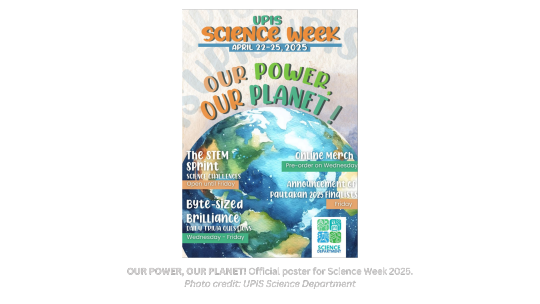
The UPIS Science Department held its annual Science Week from April 22 to 25, with the theme “Our Power, Our Planet!” centered around celebrating Earth Day. The event was conducted virtually due to the high heat index, which prompted a schoolwide shift to online classes. Throughout the week, various activities were offered to highlight how science empowers students to protect our planet.

One of the key activities during the week was the STEM Sprint, held from April 23 to 25. Each grade level, from Kindergarten to Grade 12, was given a task designed to test their knowledge and practical application of science. Students were presented with various challenges about the concepts of energy, buoyancy, climate change, and more. This year’s Science Week also featured the return of Pautakan 2025, a competition that originally included an elimination followed by a final round, where the top three scorers per class represented their respective batches. However, due to scheduling conflicts—specifically, because the following week remained in remote mode, the finals round was canceled. Instead, the top three scorers from each section during the elimination round were awarded tokens.
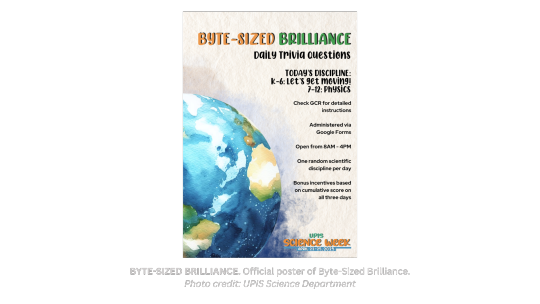
Another activity was the Byte-Sized Brilliance trivia questions, released daily from April 23 to 25 from 8:00 a.m. to 4:00 p.m. The three-item quizzes were administered through Google Forms and offered themes focusing on varying disciplines of science, depending on the day and grade level. For Day 1, the themes were "Earth and Life" (K-6) and "Biology" (7-12); Day 2 featured "You Matter!" (K-6) and "Chemistry Is in the Air" (7-12); and Day 3 highlighted "Let’s Get Moving" (K-6) and "Physics" (7-12).
Bonus points for the Science subject were given as an incentive for all students who participated in the week’s events.

In addition to these activities, the Science Club and Science Society released their science-themed merchandise online. Pre-orders were available from April 23 to 25 and included pins, stickers, and phone charms. Orders were claimed during the Assessment Days, May 13 to 16, at the Science Club and Science Society’s booth in the UPIS 7-12 Ramp Area. The funds raised will be used by the Science Department for future events.
According to Asst. Prof. Laurice Pineda (Ma’am Lau), the head of the Science Department, the event invited everyone to unite in support of renewable energy and the goal of tripling the global generation of clean electricity by 2030.
When asked about the challenges Science Week faced, Ma’am Lau responded: “The sudden shift to remote learning this quarter due to high heat indices required the department to suspend all f2f-related activities such as the daily challenges, the final round of Pautakan sa Agham, as well as the science camp.” As a result, the department came up with a set of alternative online and asynchronous activities, which were posted on the Science Google Classrooms and the UPIS Science Facebook page.
Ma’am Lau also expressed her gratitude to the students for their participation in the event, despite it being held online. She stated, “The department really appreciates the students who spent their time participating in the grade level challenges, the daily trivias, and even the Pautakan. The members of the Science Club… exerted their efforts in dissemination of the activity as well as organizing their online merchandise.”
“The department will bring back the F2F versions of the grade level challenges, trivias, and the Pautakan,” Ma’am Lau said, setting an expectation for the UPIS Community for next year’s Science Week. “Expect also (that) the Science Camp will be held again in order to help UPIS students foster their knowledge, skills, love, and interest in Science.”
//by Jibril Abanag and Uno Macadaan
0 notes
Text
K-2 paints a colourful picture of UPIS life at ISKULAY
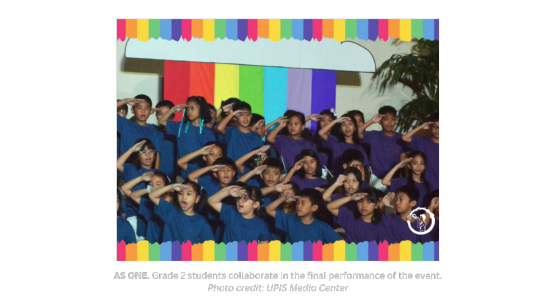
UP Integrated School K-2 students showcased their talents in a culminating activity dubbed ISKULAY: Ang Buhay ng Isko at Iska ay Makulay! at the UP Film Center on May 17, 2025.
The idea for ISKULAY emerged in response to the pandemic and the restrictions on school performances. Unlike previous pre-pandemic events, which were limited to members of the K-2 club Teatro Munti, this year’s event included all students from Kindergarten through Grade 2.
Organized by the K-2 Department, the event featured dance performances from the Kindergarten to Grade 2 sections. The culminating activity was staged in two shows: one featuring the AM classes from 9:00-10:30 and the other the PM classes from 1:30-3:00 PM.

Both segments began with a special performance by Kontra-Gapi, the resident ethnic music and dance ensemble of the UP Diliman College of Arts and Letters. The group was introduced by Amelia Hope S. Dungca from K-Dahlia in the morning, and by Monica Margarete R. Archog from K-Liryo in the afternoon.
Each section's performance began with an introduction by a representative, followed by a montage highlighting the section's experiences throughout the school year. This included class activities, dance workshops, field trips, Literary Week, Thanksgiving Day, UPIS Days, and many more, featuring photos of each student that captured the memories and moments that defined their year.
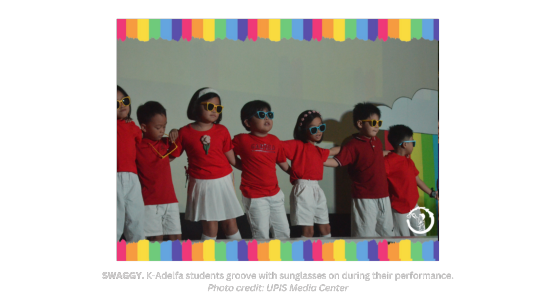
The AM segment opened with a performance from K-Adelfa, while K-Liryo led the PM segment. Both sections performed “Umagang Kay Ganda” by Barbie Almalbis, concluding their routines by putting on sunglasses and linking arms.
Followed by the first performance, the class of K-Dahlia took over the stage in the AM segment, and K-Mirasol during the PM segment. Dancing to “Sukob Na” by Aiza Seguerra, both classes incorporated umbrellas into their choreography to close their routine.

Grade 1 presentations came next with 1-Myna in the morning and 1-Kalaw in the afternoon. Their routine featured a medley of “Oras Na Para Magbasa” by Rivermaya and Jolina Magdangal and “Sine’skwela” by Ryan Cayabyab, incorporating children’s books into the choreography.
Next were 1-Pipit and 1-Tagak, who performed in the AM and PM segments respectively. They performed to “Luksong Tinik” by Joey Ayala, including movements that demonstrate the traditional Filipino street game referenced in the song.

Then, Grade 2 performances opened with 2-Kaimito in the morning and 2-Langka in the afternoon. Both classes danced to “Isang Pamilya Tayo” by Unit 406 and Yeng Constantino, ending with illustration boards showing images of their families.
The final numbers came from 2-Papaya in the AM segment, and 2-Dalandan in the PM segment. Their performance to “Karera” by BINI featured the use of colorful flags as part of the choreography.

To close the program, Isabella VDD Cuasay of 1-Myna introduced the final performance in the morning, while Eros R. Silverio of 1-Tagak did the same in the afternoon. All K-2 students came together to perform “Awit ng Bahaghari” by Noel Cabangon, with their attire arranged in a rainbow sequence as they struck various poses throughout the routine. Each student was also given a custom-made hat as a token of appreciation and participation.
Asst. Prof. Tin Linsangan (T. Tin), K-2 Department Head, shared that starting the planning process and securing funding were their main challenges. Fortunately, strong sponsor support allowed them to raise more than enough funds, enabling them to hire event lighting and basic photo and video services.
She also emphasized that manpower from the UP Diliman Office for Initiatives in Culture and the Arts (OICA), student teachers, the UPIS Media Center, and the UPIS Boy Scouts of the Philippines (BSP) was crucial to the event’s success. Organizing it was a true all-hands-on-deck effort, with everyone contributing to the preparations. T. Tin stressed the importance of effective resourcing, stating, “Talagang kailangang ano, mag-tap into different resources na pwede naming makuha [na] within UP sana.”
“Nagkakaroon yung mga parents and students ng something to remember by n’ung K-2 sila,” T. Tin remarked, emphasizing the importance of the event in creating lasting memories for both students and their families. Additionally, the program was well-organized and engaging, making it a delightful experience for everyone in attendance.
//by Martha Caasi and Hannah Wadi
0 notes
Text
MCLive 2025: MagpaCikat is today!
Don’t forget to wear comfy clothes. If you want to dress according to the event's theme, the colors are blue, gold, and white. Make sure you have your e-ticket ready for presentation at our registration booth. Walk-ins will also be accepted.
Capture the fun! Take photos and videos at the event and tag us at @upis.mediacenter!
Gates will open at 4:00 pm at the UPIS 3-6 Bulwagan! Don’t miss out on the performances, concessionaires, and a special raffle! See you there!

1 note
·
View note
Text
FEATURE: Love, One Grade at a Time: A Watchlist of Movies About Young Love
As the sun blazes and classes wind down—there's no better time to kick back, relax, and indulge in a little kilig on screen. Whether you're spending your free time chilling at home, hanging out with friends, or hiding from the summer heat with a tub of ice cream, one thing's for sure: movies about love are a perfect way to pass the time. They’re even better when the stories hit close to home—when the characters feel real, and the emotions feel familiar.

Source: https://www.tumblr.com/ashjafari/616913533733650432/the-half-of-it-2020-dir-alice-wu
In this list, we’ll be counting down our favorite love stories in film that students from grades 7-12 can relate to. Ready to fall in love again and again? Let’s start with our first one!
For our wide-eyed freshmen: Grade 7 – Little Manhattan (2005)
Source: https://gracefuldreamer.tumblr.com/post/56817706727
[Rated G]
It’s no secret that crushes hit differently when you're young.
In Little Manhattan (2005), Gabe falls for his classmate Rosemary—and suddenly, the world looks different. Parks feel magical, bike rides feel important, and his heart won’t stop racing... even though he’s not sure what to do with all those feelings.
This movie is the perfect intro to young love: full of innocence, confusion, and those tiny moments that feel huge when you’re just starting to notice someone in a different way. It’s funny, honest, and surprisingly deep for a film about young first love.
It captures what catching feelings and falling in love can feel like as kids in Grade 7 who’ve just crossed into teen territory. This is the time when emotions are sudden, dramatic, and way more intense than you were ready for. This film encapsulates those instances when you turn something small—like a crush—into something that somehow matters a lot.
Available in the Philippines via:
Apple TV
BiliBili
For our sophomores beginning to feel more than they can explain: Grade 8 – Your Name (2016)

Source: https://animesher.com/entry/sky-anime-boy-animation-2045546/
[Rated PG-13 | Warning for profanity and depictions of drinking/smoking]
You’re not sure when it started—but things feel different now.
In Your Name (2016), Mitsuha lives in the countryside. Taki lives in the city. They’ve never met, but one day, they begin switching lives without warning. It’s strange, awkward, and kind of funny. But as they learn more about each other’s worlds, something unexpected begins to grow—a quiet connection that neither of them fully understands.
Grade 8 is when emotions start to feel bigger—even if you don’t know what to call them yet. This film captures that moment when someone suddenly matters, and you don’t know why. Just that they do.
Available in the Philippines via:
Netflix
BiliBili
For our juniors putting things into perspective: Grade 9 – Flipped (2010)

Source: https://www.tumblr.com/littlebitlost-littlebitfound/68644441239
[No official rating in the Philippines | Rated PG via the US Motion Picture Association]
They say your teenage years are for “figuring things out”—but no one warns you how messy that can get.
In Flipped (2010), Bryce and Juli take turns telling the story of their not-so-simple childhood connection. From second grade all the way into junior high, Juli’s had a crush on Bryce. But Bryce? He’s never really seen her… until now.
As they begin to grow up, the story flips—literally and emotionally. It explores the idea that it's not just about who you like, but why.
Grade 9 is when everything starts to shift—how you think, how you feel, and how you see others. One day, she’s just the annoying girl next door. The next, you’re realizing she might be the only one who’s ever truly seen you.
This film captures that slow, awkward, messy, but beautiful moment when you're caught between childish crushes and something more real. And honestly? That’s the magic of it.
Available in the Philippines via:
Apple TV
For our junior high seniors learning from past mistakes: Grade 10 – A Silent Voice (2016)

Source: https://www.tumblr.com/beyond-the-deathray/614043358404509696
[Rated G | Warning for suggestive language and depictions of attempted suicide]
They say people can change—but they don’t always say how hard that really is.
In A Silent Voice (2016), Shoya Ishida was once the loudest voice in the room—the class clown who cruelly targeted Shoko Nishimiya, the new girl with a hearing disability. But after his bullying goes too far, the tables turn: his classmates turn against him, and he spends the next few years isolated and full of regret. Now in high school, withdrawn and overwhelmed by guilt, Shoya sets out to reconnect with Shoko—not just to say sorry, but to understand her, and to find a way back to a life he thought he no longer deserved.
Grade 10 is when you begin to see the impact of your actions, and understand that real change starts with accountability.
This film is a quiet, powerful reminder that love isn’t always about romance. Sometimes, it’s about making amends, rebuilding trust, and learning to see both yourself and others with compassion.
Available in the Philippines via:
Apple TV
BiliBili
For our busy dreamers still untangling the meaning of love: Grade 11 – The Half of It (2020)

Source: https://www.tumblr.com/psychecreations/721356767107416064/its-a-wlw-thing-girls-like-girls
[No official rating in the Philippines | Rated PG-13 via the US MPA]
They say everyone deserves a love story—but some stories are harder to tell.
In The Half of It (2020), Ellie Chu is used to staying on the sidelines—writing essays for classmates, keeping to herself, and never saying what she really feels. When she's asked to ghostwrite love letters for a boy who's crushing on the same girl she quietly adores, Ellie finds herself stuck in the middle of someone else's love story… while hiding her own.
Grade 11 is when you begin to understand that love doesn’t always arrive with fireworks.
Sometimes it’s quiet. Sometimes it’s complicated. And sometimes, it teaches you more about yourself than anyone else ever could.
This isn’t a story about getting the girl. It’s about becoming yourself, and realizing that even unspoken love can be one of the most powerful kinds.
Available in the Philippines via:
Netflix
BiliBili
For our ates and kuyas standing at the edge of reality: Grade 12 — 500 Days of Summer (2009)

Source: https://www.tumblr.com/jeeyuns/779318722044313600/500-days-of-summer-2009-dir-marc-webb
[Rated PG-13 | Warning for profanity, drinking, violence, and indirect depictions of sex]
They say your first love leaves a mark. Sometimes it softens you. Sometimes it breaks you. But it always changes you.
In 500 Days of Summer (2009), Tom believes in soulmates. Summer, the girl Tom likes, doesn’t. What unfolds isn’t a love story—it’s the slow unraveling of one. A nonlinear ride through glances, inside jokes, high hopes, mixed signals, and quiet heartbreaks. It’s about falling hard, holding on too tightly, and realizing that not everyone who feels unforgettable is meant to stay.
Grade 12 is the end of something big.
It’s the final chapter of high school—the year of goodbyes, what-ifs, and almosts. It’s when you learn that not all love is mutual, not all connections are labeled, and that almost-relationships can hurt just as much as the real thing.
This film won’t give you a happy ending. And it won’t offer neat closure. But it will give you something real: The reminder that some people come into your life to teach you something—not to stay, but to help you see things more clearly.
Available in the Philippines via:
Apple TV
BiliBili
Love that lingers, even after the credits
Love isn’t just about romance—it’s also a way to understand ourselves as we grow. Through these films, we hope you get to see how love shows up in the confusion, the quiet, the laughter, and the in-betweens of student life.
With that being said, happy watching—and don’t forget to stay safe in the heat! Preferably with something cold to drink.

Source: https://www.tumblr.com/taitetsu/151625672106
//by Zab Juanico and Martin Arevalo
0 notes
Text
FEATURE: LEVEL-UP YOUR CAFFEINE POWER-UP: 5 Instant Coffee Recipes To Try
0 notes
Text
FEATURE: Anik-anik to Win it: Ang Kwento sa Likod ng Koleksyon
Anik-anik here, anik-anik there, anik-anik everywhere! Sa bag, sa ID, sa kwarto, sa damit—kahit saang sulok, may anik-anik na nakasabit o naka-display. Para sa iba, simpleng abubot lang ito. Subalit para sa mga kolektor, bawat piraso ay may kwento at halaga! Ano nga ba ang mayroon sa mga maliliit na bagay na ito at bakit ‘di natin maiwasang mangolekta? Tara! Alamin natin ang kwento sa likod ng anik-anik collection.

Nagmula sa salitang "anu-ano" ang terminong anik-anik na nangangahulugang kung anu-anong bagay na pagmamay-ari ng isang tao. Sa kasalukuyan, dumalas ang paggamit ng salitang “anik-anik”; binigyan pa nga ito ng mas tiyak na kahulugan ng karamihan bilang accessories sa iba't ibang bagay. Kung ikukumpara sa mga nakaraang henerasyon, maaaring tumutukoy ang anik-anik sa iba’t ibang bagay—mga figurine, rosaryo, vinyl records, at kahit lalagyanan o plastic bag ay kinokolekta nila. Ang ideyang ito ay matagal nang lumalaganap at mas binigyang kahulugan lamang ng makabagong henerasyon. Kamakailan, nauso at bumenta lalo sa mga kabataan ang mga blind box na naglalaman ng random na disenyo ng isang karakter—ilang halimbawa nito ay Labubu, Sonny Angel, Hirono, Smiski, Mofusand, at iba pa.
Ngunit sapat na ba ang kahulugang ibinigay rito upang lubos na maunawaan ang koneksyon ng tao sa mga anik-anik? Upang mas maintindihan ang ideya ng pangongolekta, kinapanayam namin ang ilang estudyante ng UPIS na nangongolekta ng mga anik-anik.

Karamihan sa kanila ang nangongolekta simula noong sila’y bata pa lamang, habang ang ilan naman ay nagsimula nang mas naging tanyag ang mga anik-anik sa ating bansa noong taong 2023 at 2024.
Ayon kay Caia Odulio ng 7-Earth, naimpluwensiyahan siya ng kaniyang mga nakatatandang kapatid na mangolekta. “Kapag lumalabas kami, lagi ko silang nakikitang bumibili [ng anik-anik], at over time, binibilhan na rin nila ako,” aniya. Para naman kay Tiffany Marquez ng 8-Honeybee, isa sa mga naging rason ng kaniyang pangongolekta ay ang pagiging patok sa madla ng pagkakaroon ng mga anik-anik. Ika ni Tif, “Naimpluwensyahan lamang ako nang maging uso kamakailan.” Ayon sa kaniya, nang maramdaman niya ang pag-reconnect sa mga kinagigiliwang gawain noon—tulad ng pangongolekta ng makukulay na aksesorya at pagdidisenyo nito—unti-unti itong naging bahagi ng kaniyang identidad. Sa kasalukuyan, ang mga pabitin at alahas na dati'y laruan lamang ay nagsisilbing dekorasyon sa katawan at simbolo ng kaniyang personal na estilo.
Sumasang-ayon sa sagot ni Tif, ani naman ni Arianne Pablo ng 10-Narra, “Noong pandemya, sumikat sa social media ang mga anik-anik tulad ng mini figures, keychains, at button pins, at isa ito sa mga nakapaghikayat sa akin na mangolekta—ngunit bago pa man ito nauso ay nangongolekta na ako dahil sa ugali kong sentimental.”
Tulad kay Arianne, mayroon ding sentimental value kay Nica Lagradilla ng 11-Alcala ang mga kinokolekta niyang anik-anik. “Bukod sa kung regalo ito, at naaalala ako ng isang tao sa pamamagitan ng anik-anik, o may halaga sa akin ang taong nagbigay nito, usually mayroon ding memory na naka-associate sa mga anik-anik ko,” pagpapatuloy niya.
“Ex-best friend ko…”, tugon ni Cassius Andaya ng 9-Xenon nang tanungin kung sino ang nag-udyok sa kaniya sa pangongolekta ng mga anik-anik.
Ika naman ni Esther Gabuat ng 12-Kagalingan, kahit ang mismong presensya lang ng mga anik-anik ay nagbibigay-tuwa sa kaniya. “Sadyang natutuwa lang ako kapag nakakakita ako ng mga anik-anik kaya ako nagsimulang mangolekta,” aniya.

Maliban sa kasiyahang dala ng anik-anik, may higit pa itong dulot para sa mga estudyante. Sa pamamagitan ng pagbuo ng mga koleksyon, naipapakita nila ang kanilang mga katangian na sumasalamin sa kanilang buong pagkakakilanlan at nagsisilbi itong tulay upang makakonekta sa mga taong may kaparehong hilig. Para kay Arianne, naipapakita nito ang pagmamahal nilang magkakaibigan sa bawat magkakaterno nilang anik-anik; nagbibigay-inspirasyon din ito sa kaniyang paglikha ng sariling mga disenyo. May nakasabit na memorya sa bawat anik-anik na pagmamay-ari nila—lugar man na napuntahan o mula sa mga taong nagbigay nito sa kanila.

Sa mga kolektor, tulad ng aming mga nakapanayam, ang bawat anik-anik na kanilang pagmamay-ari ay may taglay na alaala.
Ibinahagi ni Caia ang kaniyang button pin na may nakalagay na “UPIS Pep Drummers” ay isang simbolo ng pagiging bahagi ng komunidad. "Feel ko po na part ako ng team o komunidad, dahil nakasulat na po siya on paper or in this case, on a pin," aniya.
Nagkaroon naman si Tif ng isang keychain na kaniyang napanalunan sa claw machine. “Nalaglag din ito kaagad dahil hindi maganda ang kalidad ng keychain…sayang at maraming nasayang na load mula sa Timezone card,” ika niya. Naipapakita rito kung gaano kahalaga ang isang anik-anik—simple man o kakaiba. Naging memorable ang keychain, hindi lamang dahil sa kaniyang nagastos dito, kundi sa danas kung paano niya napagtagumpayang makuha.
Ayon kay Cassius, "Mayroon akong special na pin na binigay sakin ng ex-best friend ko na nasa ID ko pa rin kahit nag-F.O. (friendship over) na kami." Ang button pin na iyon ay isang simbolo ng pag-alala sa kaniyang dating kaibigan.
Para naman kay Arianne, naging malapit sa kaniyang puso ang lalagyanan niyang hugis-pusa. "Ang lalagyan na hugis pusa... si Toro Inoue... isa ito sa mga pinakaunang binili ko noong pandemya," aniya.
Itinuturing naman ni Nica bilang isa sa mahahalagang anik-anik ang evil eye at four-leaf clover phone charm na gawa ng kaniyang matalik na kaibigan. Ika niya, "Ang pagtaboy ng bad juju (malas) at pag-welcome ng good luck sa buhay ko at sa aming pagkakaibigan ay something that I really value."
Ibinahagi naman ni Esther ang kaniyang mga anik-anik na nakuha bilang freebies sa concert at mga pasalubong galing sa kaniyang kaibigan.

Sila rin ay may karanasan na sa paggawa ng sariling mga anik-anik tulad ng keychains, phone charms, button pins, at stickers. Katulad ni Arianne, siya ay may negosyong anik-anik—nagbebenta siya ng mga customized button pins na may laking 1.5 inches sa halagang dalawampung piso sa pamamagitan ng pre-order form na matatagpuan sa kaniyang business account sa Instagram na @solaris.pins.
Sa pagkolekta ng mga anik-anik, mayroong mga nag di-DIY o "Do It Yourself", nagko-customize, at ginagamit ito bilang accessories sa pananamit. Ganito naipapakita ng bawat estudyante ang kanilang pagkamalikhain sa simpleng pamamaraan. Isa na rito si Caia na gumagawa ng phone charms at keychains bilang paraan ng pagpapakita ng kanyang personal na estilo. Samantalang si Tif, na nahilig sa paggawa ng keychains mula sa mga stuffed toys, ay nagpapamalas ng kaniyang pagkamalikhain sa pamamagitan ng pagtatahi at pag-customize. Hindi rin magpapahuli si Cassius, na nag-eksperimento sa paggawa ng mga pins mula sa tansan. Si Esther, na mahilig sa pagko-crochet, ay gumagawa naman ng mga crochet keychains. Si Nica naman ay nakapagdisenyo na ng mga personalized stickers at gumagamit naman siya ng beads upang makagawa ng mga phone charms at bracelet.
Higit pa sa positibong dala nito sa mga kolektor, isang tulong din ang pangongolekta para sa mga mayroong maliit na negosyo o nagbebenta ng mga anik-anik. Sa pamamagitan ng pagbili, bukod sa pinansyal na tulong sa manininda, nagbibigay-suporta rin ito sa mga sariling sikap sa paggawa ng anik-anik. Bukod sa paggawa at pagiging bahagi ng koleksyon, pinapatunayan din ng mga anik-anik na kahit pa maliit na mga bagay ay nagkakaroon ng malaking halaga sa ating buhay. Hindi rin nakabatay sa presyo ang halaga ng isang anik-anik, kundi sa kolektor nito at kung paano niya ito pahalagahan—mapa-simpleng keychain man o figurine. Maubos man ang espasyong paglalagyan ng koleksyon, patuloy pa rin ang interes ng mga kolektor sa pag-iipon ng mga anik-anik, dahil bukod sa pagiging palamuti, nagsisilbi rin itong alaala, inspirasyon, o simbolo ng personalidad ng isang tao.
Bagaman kasalukuyang sikat ang mga anik-anik, matagal na itong nagbibigay ng kasiyahan, aliw, at pakiramdam ng koneksyon sa ating sarili at sa mga alaala ng ating karanasan. Ang pangongolekta ay isang simpleng paraan ng pag-alala at pagbuo ng koneksyon sa ating sarili at kapwa. Hindi lamang ito uso—isa itong paalala na tayong lahat ay may kaniya-kaniyang kwento na nais ingatan, bigyang-halaga, at ibahagi.
//nina Bianca Regala at Andrea Rebaldo
Sanggunian:
Pamintuan, R. (2024, August). Collecting joy: ‘Anik-anik’ then and now. Philstar Life. https://philstarlife.com/geeky/505578-collecting-joy-anik-anik-then-now?page=2
3 notes
·
View notes
Text
FEATURE: VET DAY, YAY! Inspiring Care and Piquing the Minds of K-2 Students for Animals
Have you ever tried taking care of an animal?
Dogs, cats, and many more,
Caring for animals is more than just play!
Last March 14 to 15, 2025, K-2 had a Vet Day!
Veterinarian Day!

The Vet Day was held at the UPIS K-2 building, where UPIS Kindergarten students had the opportunity to learn about how to take care of animals with Dr. Caitlin Vea Noroña and Dr. Amanel L. Manalo. The event aimed to enhance the students’ science lessons relating to animals and their needs. According to Teacher Kat Loyola, the Kindergarten Level Coordinator, it also aimed to appreciate the work of veterinarians and other workers such as farmers who dedicate their lives working with animals and providing food.
The guests provided a glimpse into the role of vets in both private and public settings to ensure animal health in clinics or on a national scale.
About Dr. Noroña and Dr. Manalo
Guess what, our guests are actually UPIS alumni! Dr. Noroña is from UPIS Batch 2018 while Dr. Manalo is from UPIS Batch 2011.
Dr. Noroña recently graduated last August 2024, and passed the licensure exam in November of the same year. She shared that ever since learning the word “veterinarian,” it has always been her goal to become one. She currently works as a small animal veterinarian in Mount Sinai Veterinary Practice, a private clinic in Taguig.
As for Dr. Manalo, he has always seen himself working in the field of medicine, but not specifically becoming a vet. “In retrospect, I cannot imagine doing anything else—veterinary medicine feels exactly where I was meant to be,” he said. Having previously worked as a field veterinarian in Mindanao, a companion animal practitioner in Metro Manila, and a regulatory officer, he now works at the Animal Disease Diagnosis and Reference Laboratory in Quezon City. There, they support national animal health through laboratory services, policy development, technical assistance, and project implementations.

Coming back to UPIS definitely brought back old memories for these alums. Dr. Noroña shared that the building looked way smaller than she remembered. She couldn't help but feel nostalgic and reminisce on their experiences and on the things UPIS has taught them. “It was where I started to think about how I like to take care of animals, and now it's where I shared my story of taking care of animals as a full-time job to the next generation sitting on the same floor I sat in.”
The event was also a comforting and heartwarming return for Dr. Manalo. “While many things have improved, such as the playground, the familiar sights—the classrooms and the library—(it) still felt wonderful,” he shared.
Returning to where they started feels like they are at home again. From pondering what to do in the future and deciding what they want, to being one of the successful veterinarians out there. Dr. Norona and Dr. Manalo came back to UPIS, but this time to influence animal care, foster empathy, and encourage children to take an interest in animals.
Inspiring Young Generations

Our guests both shared that the Vet Day was a wonderful opportunity for children to be exposed to animal care and to the profession. It gave the students a space where they could share more about the animals they know, ask questions about animals and how to care for them, and learn about the role of vets and humans in general when handling animals.
“You have to be thoughtful since we’re not only thinking about animals, but we also think of humans who are affected as well,” Dr. Manalo reminded the students. Both Dr. Noroña and Dr. Manalo discussed the basic needs of animals, particularly pets—food, water, shelter, and of course, love.
In the Q&A, the most interactive part, students were encouraged to ask questions and apply their current knowledge about animals, sparking their curiosity more. Some of the kids’ questions were “How do you find love birds?” and “How to take care of wild animals?” They began to create connections between what they learn in class and the world beyond school. “This deeper engagement supports their development not only in Agham but also in communication, critical thinking, and social awareness,” Teacher Kat stated.

Dr. Noroña hopes that the children will be encouraged to advocate for animal rights and protection from cruelty and inhumane practices. “From there, when they discover that they want to pursue this profession in the future, I also want them to remember that someone in their past encouraged them to do it.”
“Being a veterinarian is not just about providing care for animals, but also about making a meaningful impact on people’s lives, and the environment that we share with them,” Dr. Manalo shared. He hopes that the children would find joy in helping others.
Teacher Kat also mentioned that UPIS K-2 has a recurring activity called Parent Idol, where children get to learn the career of their classmates’ parents. In the future, if some topics align with other professions, similar events may be organized. “These could include careers like farmers, journalists, doctors, nurses, artists, social and environmental workers—professions that also tie into the children’s learning themes and developmental goals,” she shared.
The Vet Day helped our young Isko and Iskas to unlock their wonderment and plant seeds for future careers.
//by Arunee Licerio & Thrizah Ramilo
3 notes
·
View notes
Text
FEATURE: MCynopsis: A glimpse into the Media Center experience
Covering school events and writing various literary works—these are only a few of the many outputs brought to life by UPIS’s official student publication, Media Center (MC). Believe it or not, MC has been around for more than 30 years, while Ang Aninag Online (AAO), its shift to the digital medium, is turning 14. With many years under its belt, the history of this organization has grown extensive and has been filled to the brim with all sorts of memories and experiences. If you are curious about the people, the work, and the stories behind it all, then look no further! Let us dive in as some of the past and present members give a synopsis of their MC life.
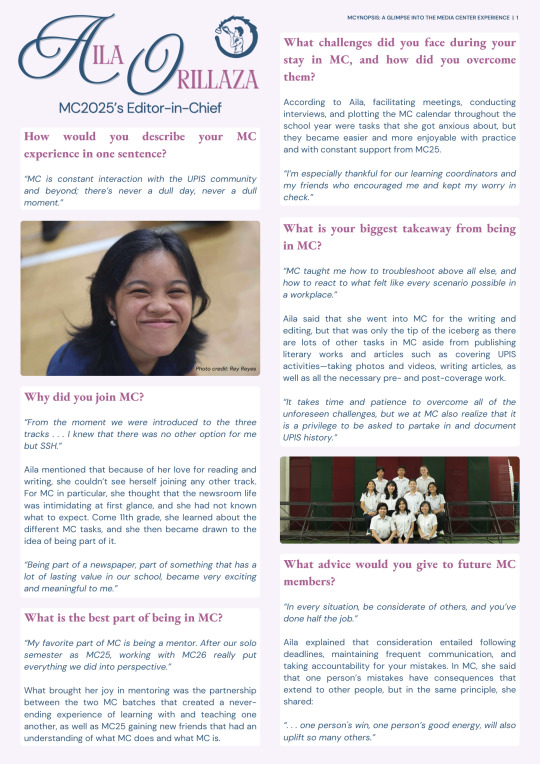



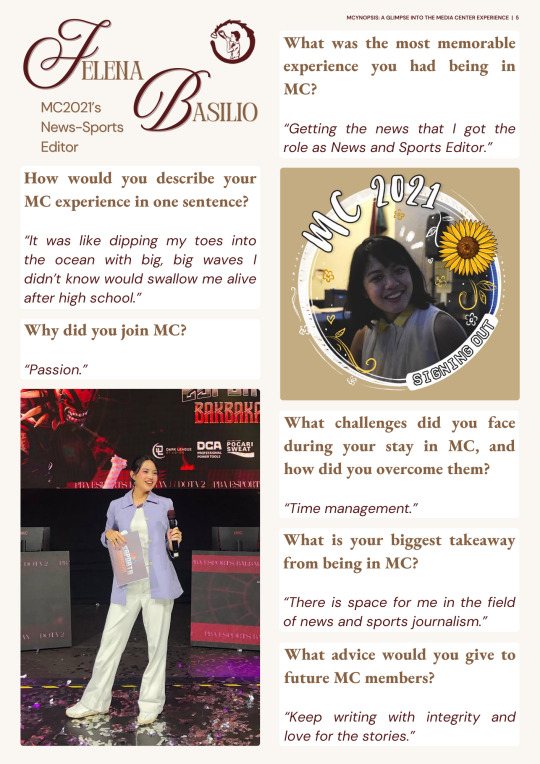
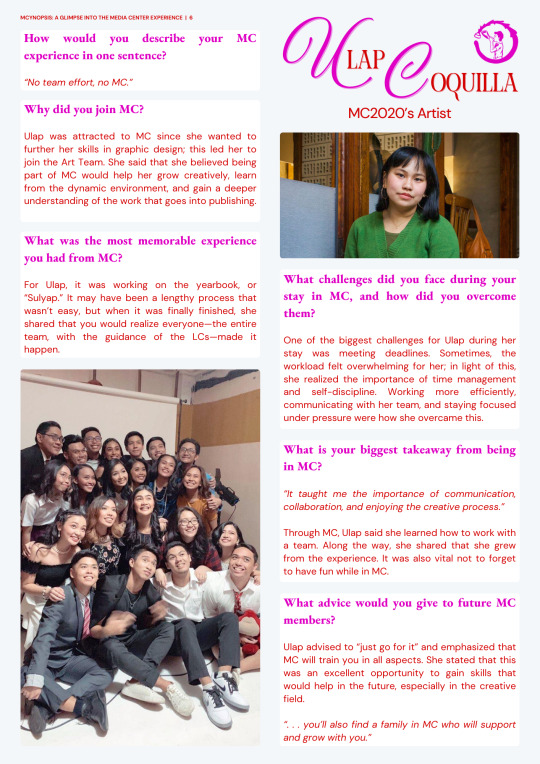
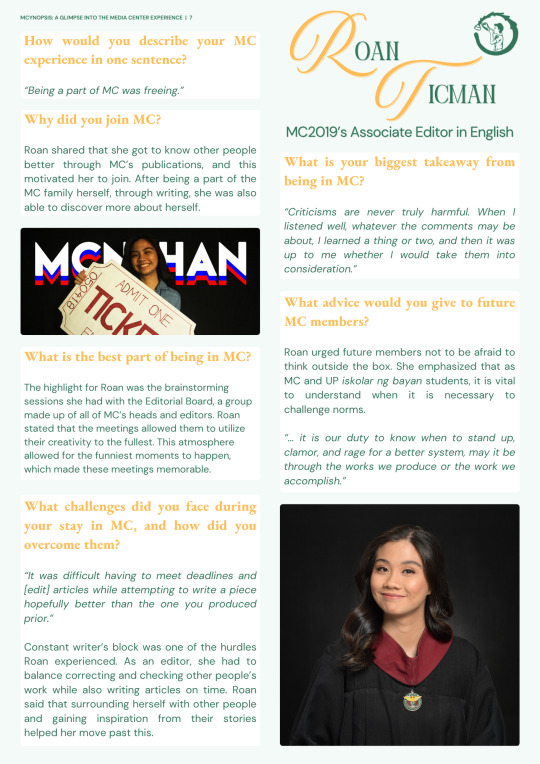


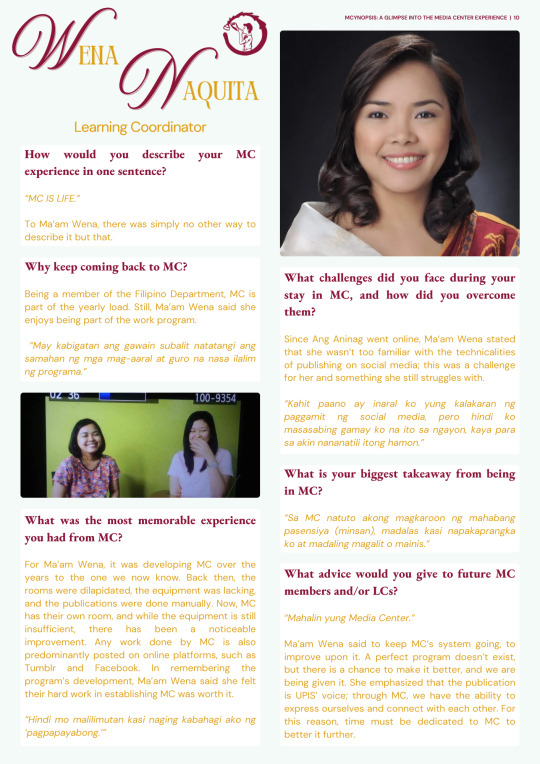

To synopsize (MCynopsize, if you would), it is safe to say that being a part of MC does not only shed light on pertinent topics around the UPIS community, but also on the talents of its students. If you feel a passion glimmering within you—one for writing, reading, serving the community, and working with others—know that we have a place for you here. Be part of those who illuminate with their light; be part of MC!
//by Elis Reyes and Arwen Chanliongco
2 notes
·
View notes
Text
What’s up, madlang pipol? 🗣️
Store mo 🏪, show mo 👀! Narito na ang mga magpapaganda ✨, at magpapasarap ☕ ng ating hapon sa MCLive 2025: MagpaCikat!
Kita-kits ngayong May 16, 2025, 4:30-7:00 PM sa 3-6 Bulwagan! 💙
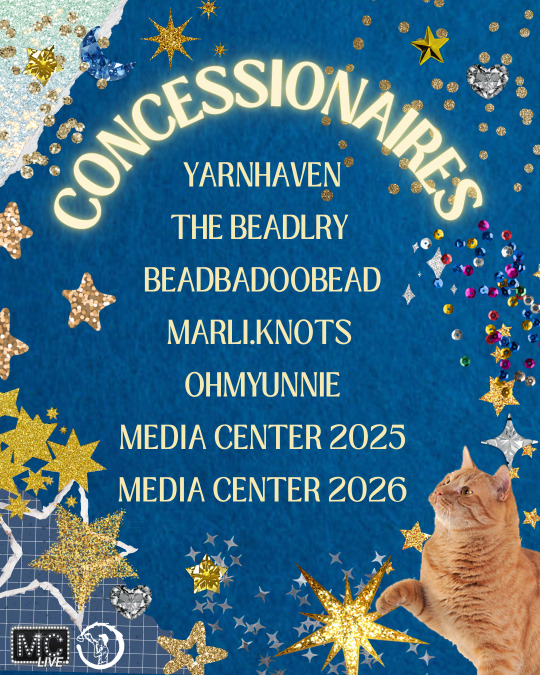
0 notes
Text
What’s up, madlang pipol? 🗣️
Tinatawag na kayo 🫵 ng tanghalan! Narito na ang mga magpapakitang-gilas 🎤 sa MCLive 2025: MagpaCikat!
Handa na ba kayong makita 👀 ang mga sample nila? Kita-kits ngayong May 16, 2025, 4:30-7:00 PM sa 3-6 Bulwagan! 💙




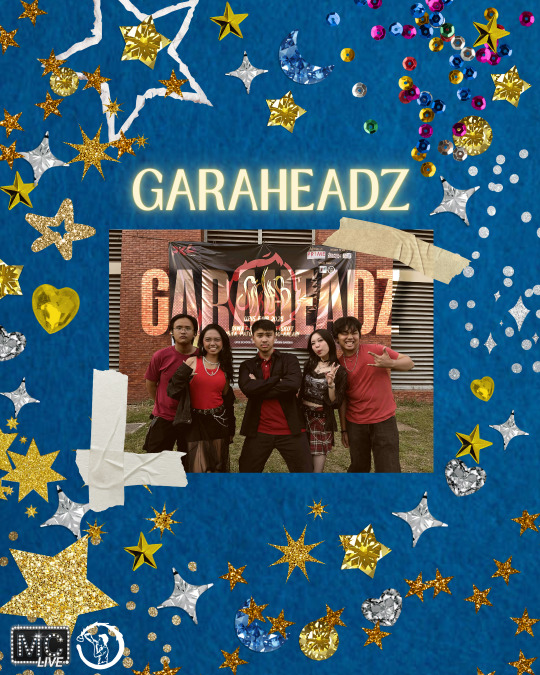




0 notes